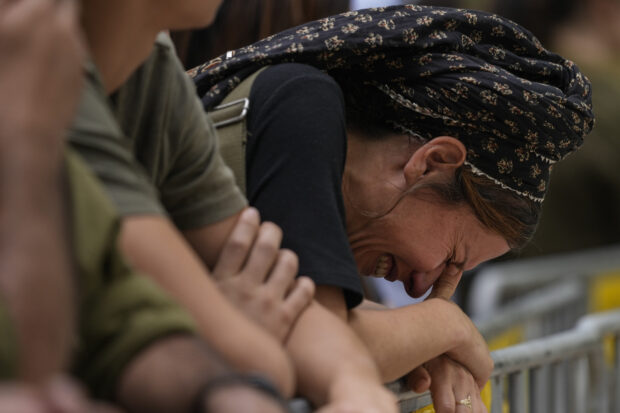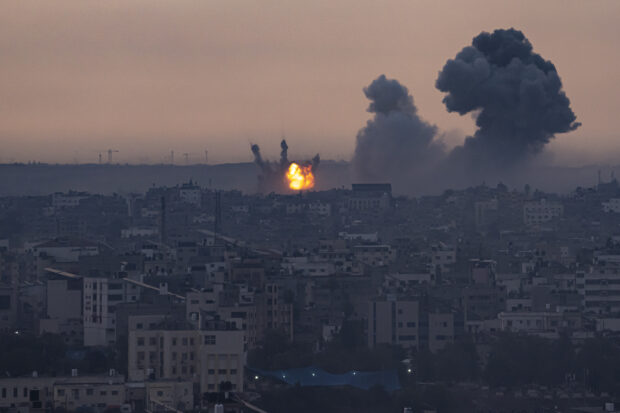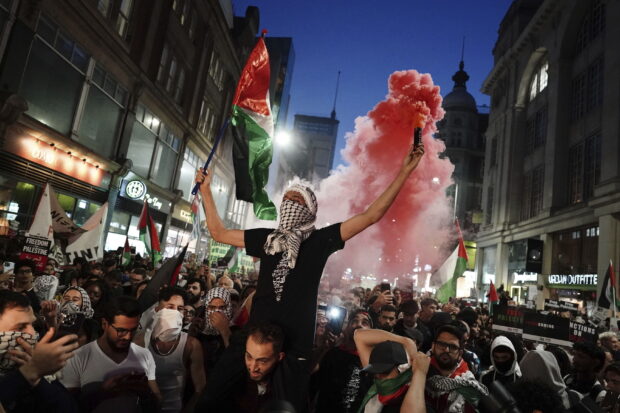Israel strikes and seals off Gaza as Hamas vows to execute hostages

A woman cries during the funeral of Israeli Col. Roi Levy at the Mount Herzl cemetery in Jerusalem on Monday, October 9, 2023. Col. Roi Levy was killed after Hamas militants stormed from the blockaded Gaza Strip into nearby Israeli towns. Israel’s vaunted military and intelligence apparatus was caught completely off guard, bringing heavy battles to its streets for the first time in decades. (AP Photo/Maya Alleruzzo)
JERUSALEM — Israel increased airstrikes on the Gaza Strip and sealed it off from food, fuel, and other supplies Monday in retaliation for a bloody incursion by Hamas militants, as the war’s death toll rose to nearly 1,600 on both sides. Hamas also escalated the conflict, pledging to kill captured Israelis if attacks targeted civilians without warnings.
In the war’s third day, Israel was still finding bodies from Hamas’ stunning weekend attack into southern Israeli towns. Rescue workers found 100 bodies in the tiny farming community of Beeri — around 10% of its population — after a long hostage standoff with gunmen. In Gaza, tens of thousands fled their homes as relentless airstrikes leveled buildings.
The Israeli military said it had largely gained control in the south after the attack caught its vaunted military and intelligence apparatus completely off guard and led to fierce battles in its streets for the first time in decades. Hamas and other militants in Gaza say they are holding more than 130 soldiers and civilians snatched from inside Israel.
READ: Israel drafts 300,000 reservists as it goes on the offensive
Israeli tanks and drones were deployed to guard breaches in the Gaza border fence to prevent new incursions. Thousands of Israelis were evacuated from more than a dozen towns near Gaza, and the military summoned 300,000 reservists — a massive mobilization in a short time.
Article continues after this advertisementThe moves, along with Israel’s formal declaration of war on Sunday, pointed to Israel increasingly shifting to the offensive against Hamas, threatening greater destruction in the densely populated, impoverished Gaza Strip.
Article continues after this advertisement“We have only started striking Hamas,” Israeli Prime Minister Benjamin Netanyahu said in a nationally televised address. “What we will do to our enemies in the coming days will reverberate with them for generations.”

Smoke rises after the Israeli air strike in the Gaza Strip on Monday, October 9, 2023. Israel’s military battled to drive Hamas fighters out of southern towns and seal its borders Monday as it pounded the Gaza Strip. (AP Photo/Fatima Shbair)
As the Israeli military brought additional forces near the border, a major question was whether it will launch a ground assault into the tiny Mediterranean coastal territory. The last ground assault was in 2014.
Around 900 people, including 73 soldiers, already have been killed in Israel, according to media. In Gaza, more than 680 people have been killed, according to authorities there; Israel says hundreds of Hamas fighters are among them. Thousands have been wounded on both sides.
READ: These photos show fear, death and destruction in Israel and Gaza Strip
In response to Israel’s aerial attacks, the spokesman of Hamas’ armed wing, Abu Obeida, said Monday night that the group will kill one Israeli civilian captive any time Israel targets civilians in their homes in Gaza “without prior warning.”
Israeli Foreign Minister Eli Cohen warned Hamas against harming any of the hostages, saying, “This war crime will not be forgiven.” Netanyahu appointed a former military commander to manage the hostage and missing persons crisis.
READ: What is Hamas? The group that rules Gaza Strip has fought several rounds of war with Israel
Israel and Hamas have had repeated conflicts in past years, often sparked by tensions around a Jerusalem holy site. This time, the context has become potentially more explosive. Both sides talk of shattering with violence a yearslong Israeli-Palestinian deadlock left by the moribund peace process.
The surprise weekend attack by Hamas left a death toll unseen since the 1973 war with Egypt and Syria. That fomented calls to crush Hamas no matter the cost, rather than continuing to try to bottle it up in Gaza. Israel is run by its most hard-right government ever, dominated by ministers who adamantly reject Palestinian statehood.
READ: Israel declares war, bombards Gaza Strip: 5 Things to Know
Hamas, in turn, says it is ready for a long battle to end an Israeli occupation it says is no longer tolerable. Desperation has grown among Palestinians, many of whom see nothing to lose under unending Israeli control and increasing settler depredations in the West Bank, the blockade in Gaza and what they see as the world’s apathy.
Attacks by both sides created more scenes of devastation Monday. In Israel’s southern coastal city of Ashkelon, a man holding a crutch with one hand and an older boy with the other joined evacuees being shepherded from a street after a rocket blew out the front of a house.

Protesters shout during the “Jewish Community Vigil” for Israel in London, Monday, October 9, 2023, two days after Hamas fighters launched an unprecedented, multi-front attack on Israel which killed more than 700 people. The militants blew through a fortified border fence and gunned down civilians and soldiers in Israeli communities along the Gaza frontier during a Jewish holiday. (AP Photo/Kin Cheung)
In Gaza, Palestinians passed the bodies of the dead through dense crowds of men in the rubble in the Jebaliya refugee camp.
Early Monday evening, the sound of explosions echoed over Jerusalem when a volley of rockets fired from Gaza hit two neighborhoods — a sign of Hamas’s reach. Israeli media said seven were wounded.
READ: How Israel was duped as Hamas planned devastating assault
Israeli warplanes carried out an intense bombardment of Rimal, a residential and commercial district of central Gaza City, after issuing warnings for residents to evacuate. Amid continuous explosions, the building housing the headquarters of the Palestinian Telecommunications Company was destroyed.
Israeli airstrikes on Gaza have razed 790 housing units and severely damaged 5,330, the U.N. Office for the Coordination of Humanitarian Affairs said early Tuesday. Damage to three water and sanitation sites have cut off services to 400,000.
Israeli Defense Minister Yoav Gallant ordered a “complete siege” on Gaza, saying authorities would cut electricity and block the entry of food and fuel.
Jan Egeland, secretary general of the Norwegian Refugee Council aid group, warned that Israel’s siege would spell “utter disaster” for Gazans.
“There is no doubt that collective punishment is in violation of international law,” he told The Associated Press. “If and when it would lead to wounded children dying in hospitals because of lack of energy, electricity and supplies, it could amount to war crimes.”
READ: Israel and Palestinian war: What you need to know right now

People take part in a Palestine Solidarity Campaign demonstration near the Israeli Embassy, in Kensingston, London, as the death toll rises amid ongoing violence in Israel and Gaza following the attack by Hamas, Monday, October 9, 2023. (Jordan Pettitt/PA via AP)
The Israeli siege will leave Gaza almost entirely dependent on its crossing into neighboring Egypt at Rafah, where cargo capacities are lower than other crossings into Israel.
An Egyptian military official, speaking on condition of anonymity because he was not authorized to talk to the press, said more than 2 tons of medical supplies from the Egyptian Red Crescent were sent to Gaza and efforts were underway to organize food and other deliveries.
Tens of thousands of Gaza residents continued to flee. The United Nations said Tuesday that more than 187,000 of Gaza’s 2.3 million people have left their homes — the most since a 2014 air and ground offensive by Israel uprooted about 400,000.
UNRWA, the United Nations agencies for Palestinian refugees, is sheltering more than 137,000 people in schools across the territory. Families have taken in some 41,000 others.
READ: Hamas attack: How many foreigners killed, missing or abducted?
In the southern Gaza city of Rafah, an Israeli airstrike early Monday killed 19 people, including women and children, said Talat Barhoum, a doctor at the local Al-Najjar Hospital.
Hundreds of Hamas militants were buried under rubble of buildings destroyed by Israel in the past 48 hours, according to Israeli Rear Adm. Daniel Hagari. His claims could not be confirmed.
New exchanges on Israel’s northern border Monday raised worries that the war could spread to a new front.
Palestinian militants from the Islamic Jihad group slipped from Lebanon into Israel, sparking Israeli shelling into southern Lebanon. Lebanon’s Hezbollah militant group said five of its members were killed, and it retaliated with a volley of rockets and mortars at two Israeli army bases across the border.
After breaking through Israeli barriers with explosives at daybreak Saturday, an estimated 1,000 Hamas gunmen rampaged for hours, gunning down civilians and snatching people in towns, along highways and at a techno music festival attended by thousands in the desert. Palestinian militants have also launched around 4,400 rockets at Israel, according to the military.
READ: Israel, Gaza reel as death toll exceeds 1,000 in war with Hamas
Hamas spokesman Abdel-Latif al-Qanoua told the AP that the group’s fighters continued to battle outside Gaza and had captured more Israelis as recently as Monday morning.
He said the group aims to free all Palestinian prisoners held by Israel, which in the past has agreed to lopsided exchange deals in which it released large numbers of prisoners for individual captives or even the remains of soldiers.
Among the captives are soldiers and civilians, including women, children and older adults, mostly Israelis but also some people of other nationalities.
Hamas has ruled Gaza since driving out forces loyal to the internationally recognized Palestinian Authority in 2007, and its rule has gone unchallenged through the blockade and four previous wars with Israel.
Meanwhile in the West Bank, Palestinians entered a fourth day under severe movement restrictions. Israeli authorities have sealed off crossings to the occupied territory and closed checkpoints, blocking movement between cities and towns. Clashes between rock-throwing Palestinians and Israeli forces in the territory since the start of the incursion have left 15 Palestinians dead, according to the United Nations.